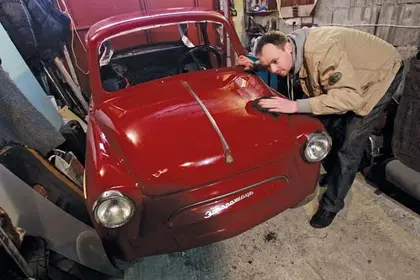Zaporozhets first came off the factory conveyer in 1960 in Ukraine’s southeastern industrial city of Zaporizhya. The cheapest Soviet car, it was booed for its awkward trunk design. Its various models were called hunchbacks, big-eared and soap boxes, but a low price made Zaporozhets a people’s car. Its sturdiness and relative ease of repairs was a part of the bargain.
The original version of Zaporozhets ZAZ-965 was basically a ripoff of the popular Italian Fiat 600, which was easy to mass produce. The price of the original Zaporozhets was 1,800 Soviet rubles, which is often compared to the price of 1,000 bottles of vodka. A regular engineer’s salary in those days was about 120 roubles.
- Get the latest war in ukraine update from the Kyiv Post's daily news reports published today.
- Receive the latest Ukraine news bulletins for today.
JOIN US ON TELEGRAM
Follow our coverage of the war on the @Kyivpost_official.
Nearly 320,000 units of the first model of Zaporozhets were produced by 1969. About 3.5 million automobiles of all models were churned out over 34 years, before production ended in 1994.
Mykola Kazakov, a 31-year-old programmer and Zaporozhets enthusiast, bought his 1968 model of ZAZ-965A for $400 in 2002. He says now the car has become his friend.
“When the former owner drove over to my place, I noticed a sticker on the windshield saying ‘a friend for sale’,” Kazakov smiles. “Now I can say the same thing about this car.”
Kazakov is a part of a community devoted to loopy modifications of the old Zaporozhets. Vladimir Putin, the Russian president-elect, is a proud owner of a 1972 model, indicating that people of all ranks are partial to the good old product of the Soviet industrial design.

PICTURES: Kyiv in the Wake of Russia’s Devastating Missile Attack

A version of the old Zaporozhets.
The original ZAZ-965 has an insect-like shape, hence its nickname: hunchback. But Kazakov finds the car’s silhouette charming.
“I’ve liked the shape of the hunchback Zaporozhets since my childhood,” he confesses. “Its appearance always produces positive emotions, and I even like the sound of its engine.”
The model had a number of versions specially designed for the disabled World War II veterans, who got their cars at vast discounts. There was a posher version of this model that was made for export, and called Yalta or Jalta.
Kazakov tries to keep his Zaporozhets true to the original looks. “This winter I began a major reconstruction of my car to produce a two-colored classic Yalta version,” he says. “Though I need to make it more modern inside.”
The next model of Zaporozhets, ZAZ-966, was kicked off in 1966. Like its parent, it had an engine at the back, as well as it’s own idiosyncrasy – comical ear-like air vents, for which it earned the nickname “big-eared.”
Despite being the butt of many jokes, Zaporozhets turned out to have wonderful cross-country qualities, for which it was much praised by its owners.
Yuri Pulyayev, a 25-year old resident of Dnipropetrovsk, owns two big-eared models. “A Zaporozhets defies almost any road; it copes with the thick snow cover,” Pulyayev boasts.
He does not mind to see smiles on people’s faces when they see him drive his car. He said smiles and pokes used to offend him, but not any more. “I can afford a modern automobile, but I don’t want to,” he says.
Even though the production of Zaporozhets ended 18 years ago, the community of its owners is still very vibrant.
Even though the production of Zaporozhets ended 18 years ago, the community of its owners is still very vibrant. They have forums on the Internet, and convene often to share experiences and mark important dates in the legendary car’s history.
The Kyiv club of Zaporozhets fans celebrated its 10th anniversary in 2010 with a convention of 60 cars.
“Our club is based on camaraderie and cooperation,” says Kazakov, who is a member of Kyiv’s club.
“Someone can do welding, another is a guru of electrical things. I would have never been able to do up my car if my friends hadn’t helped me,” he says.
Kazakov says that despite the jokes, Zaporozhets is a technologically sound car. He calls it a DIY kit for adults.
“There is no ground for creative work when the new car is under warranty. You just take it and drive it,”`he says.
He also adds that, unlike most modern cars, it has a very distinctive design. “Both the Zaporozhets and other classic cars were striking. There was something in them.”
Kyiv Post staff writer Denis Rafalsky can be reached at [email protected].
You can also highlight the text and press Ctrl + Enter







